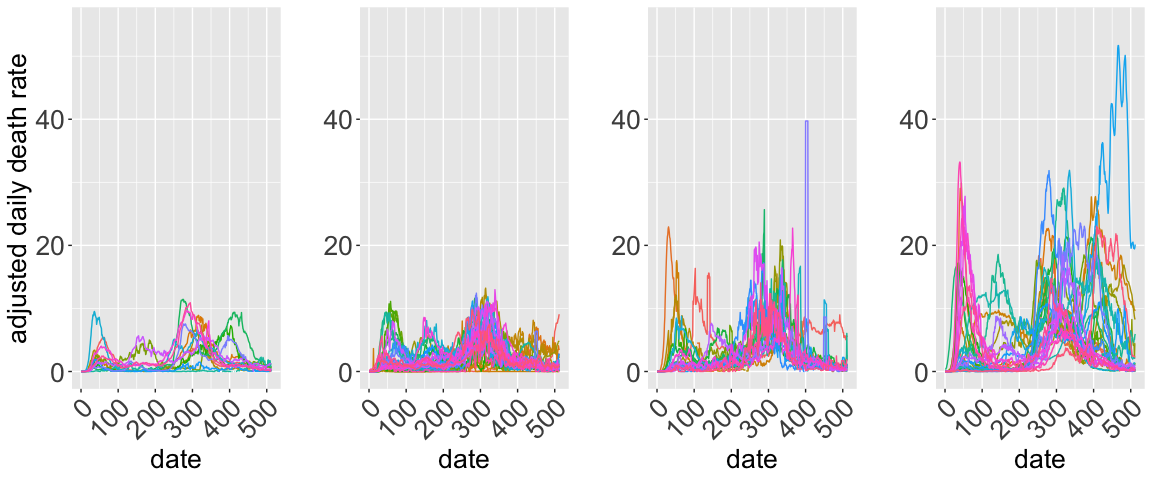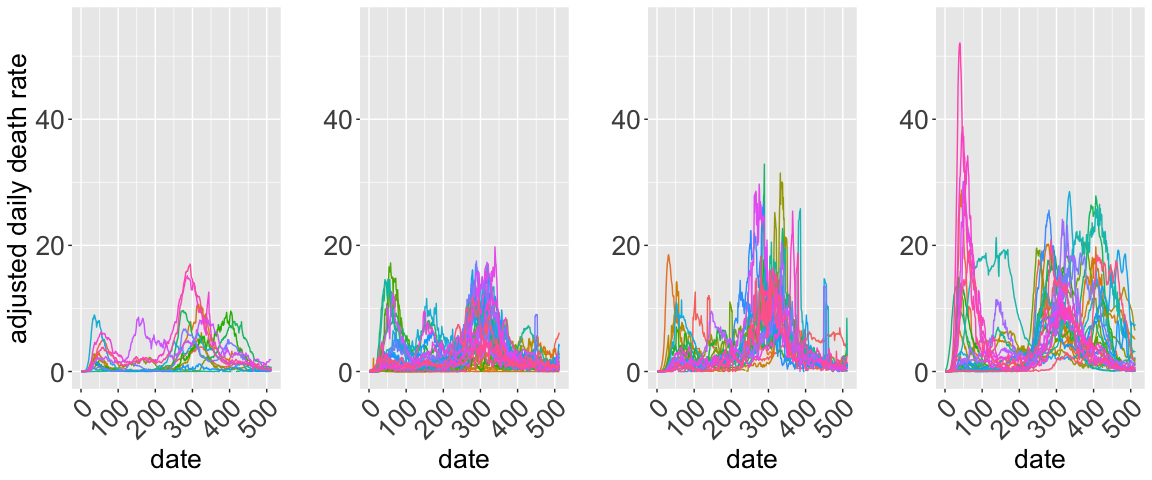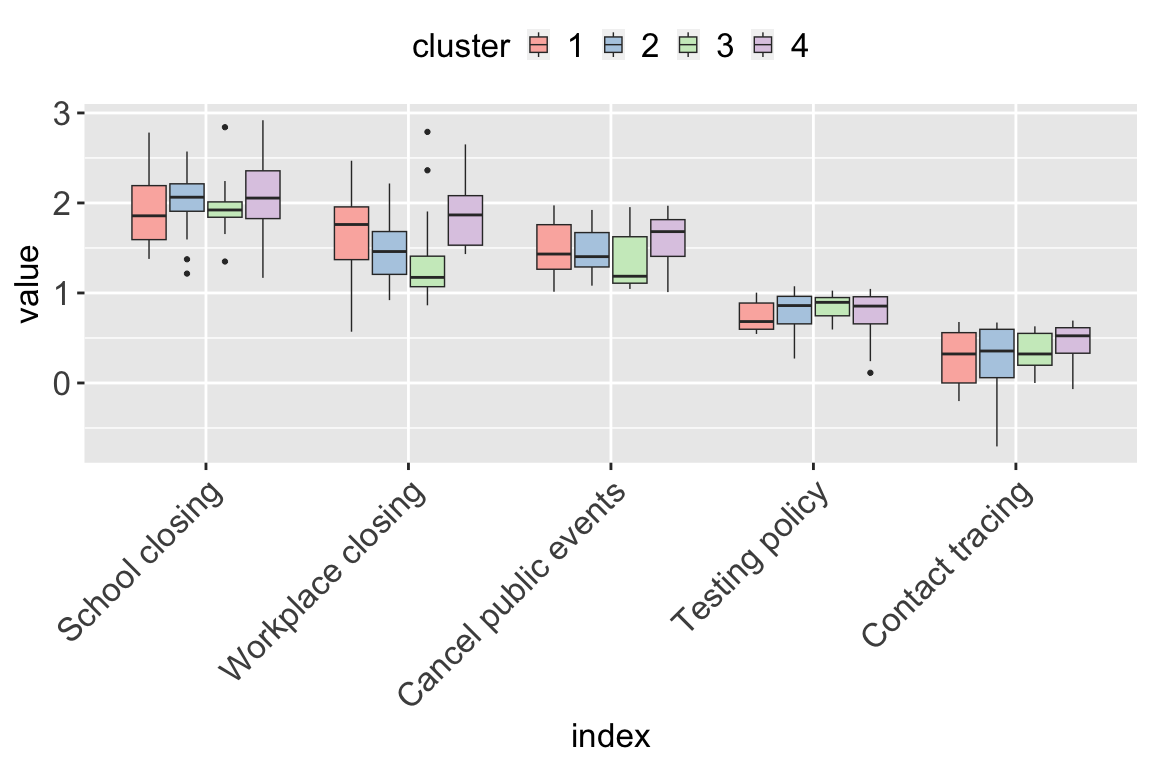The codes in this allow to reproduce the simulations presented in Cheam et al. (2023) https://hal.science/hal-03952739/.
The packages icamix, denpro and regpro, need to be installed from
the source (because they were removed from the CRAN repository).
R CMD INSTALL icamix_1.0.6.tar.gzR CMD INSTALL denpro_0.9.2.tar.gzR CMD INSTALL regpro_0.1.1.tar.gzThe package and code execution require the installation of the following external libraries:
package_list <- c("regpro",
"forcats",
"latex2exp",
"ggplot2",
"fda",
"mixtools",
"HDclassif",
"VGAM",
"rwavelet",
"BiocManager",
"dtw",
"NMF",
"sClust",
"geoR",
"zoo",
"stringr",
"FactoMineR",
"xtable",
"gridExtra",
"dplyr",
"MASS",
"VarSelLCM")Install missing packages:
isinstall <- sapply(package_list,
function(x) x %in% rownames(installed.packages()))
package_list[isinstall]
sapply(package_list[!isinstall], install.packages)Also install Biobase:
BiocManager::install("Biobase")The codes are based on the Clustfun package, companion of the paper
Cheam et al. (2023). To install the package, execute the following
command in a terminal:
R CMD INSTALL --build Clustfun_1.0.0.tar.gzBelow, all the information are gathered to reproduce the numerical results presented in the paper.
The dataset (COVIDfull.rda) was built from the files
COVID-19_LUT.csv and Policy.rds downloaded from
https://github.com/CSSEGISandData/COVID-19_Unified-Dataset Badr et al.
(2023). The data and scripts are stored in the folder
builddata-August2021/.
Load Section2.R to reproduce Figure 1.
source("Section2.r")Load Section4_1plot.R to reproduce Figures 2–4. The results are stored
in resultsSection4_1.rda and can be re-executed running
Section4_1run.R.
source("Section4_1plot.r")Load Section4_2plot.R to reproduce Figures 5–6. The results are stored
in resultsSection4_2.rda and can be executed running
Section4_2run.R.
source("Section4_2plot.r")Load Section4_3plot.R to reproduce Figures 7–8. The results are stored
in resultsSection4_3.rda and can be executed running
Section4_3run.R.
source("Section4_3plot.r")The results of this section can be reproduced by running Section5-1.R
source("Section5-1.r")| 1 | 2 | 3 | 4 | 5 | 6 | |
|---|---|---|---|---|---|---|
| PM2.5_PopWtd | -0.5664122 | 0.0212741 | -0.4345034 | 0.0000121 | 0.1993832 | 0.0540271 |
| NO2_PopWtd | 0.7958363 | 0.3504402 | 0.3072890 | 0.0025897 | 0.0413344 | 0.6924301 |
| WorldPop_Density | 0.5089838 | 0.0000000 | -0.0061600 | 0.9530119 | -0.3229638 | 0.0014989 |
| Diabetes | 0.2816515 | 0.4229080 | 0.7646337 | 0.0000000 | -0.4502616 | 0.0000053 |
| Obesity | 0.3336598 | 0.0466550 | 0.8527638 | 0.0000000 | -0.1532284 | 0.1403605 |
| Smoking | -0.2871324 | 0.1308322 | -0.0830285 | 0.4262674 | 0.8082869 | 0.0000000 |
| COPD | 0.4248760 | 0.0081631 | 0.7307828 | 0.0000000 | 0.1981437 | 0.0555693 |
| CVD | 0.3014341 | 0.5895446 | 0.8457820 | 0.0000000 | 0.0678408 | 0.5158928 |
| HIV | 0.3708583 | 0.0000000 | 0.2717158 | 0.0080689 | -0.6904543 | 0.0000000 |
| Hypertension | 0.1964048 | 0.7902244 | 0.8214016 | 0.0000000 | 0.3441937 | 0.0006817 |
| WorldPop_65 | 0.0528298 | 0.0438759 | 0.2901739 | 0.0045538 | 0.8435328 | 0.0000000 |
Table 2
The results of this section can be reproduced by running Section5-2.R
source("Section5-2.r")| 1 | 2 | 3 | 4 | 5 | 6 | 7 | 8 | 9 | 10 |
|---|---|---|---|---|---|---|---|---|---|
| 1.000 | 2.000 | 3.000 | 4.000 | 5.000 | 6.000 | 7.000 | 8.000 | 9.000 | 10.000 |
| -1377.804 | -1237.954 | -1187.733 | -1136.491 | -1114.798 | -1100.366 | -1065.731 | -1054.002 | -1055.569 | -1034.302 |
Table 3
| 1 | 2 | 3 | 4 |
|---|---|---|---|
| 338.9082 | 387.0266 | 585.7333 | 1350.0617 |
| 387.0266 | 371.4739 | 534.7584 | 1185.9924 |
| 585.7333 | 534.7584 | 549.9975 | 958.6426 |
| 1350.0617 | 1185.9924 | 958.6426 | 1084.5153 |
Table 4
| 1 | 2 | 3 | 4 | 5 | 6 | 7 |
|---|---|---|---|---|---|---|
| 0.1407480 | 860.0971 | 397.0239 | 958.8668 | 638.6910 | 1.0105156 | 0.4079440 |
| 0.3312190 | 1030.5490 | 414.8785 | 1219.6178 | 711.3828 | 1.1112846 | 0.3566133 |
| 0.2196141 | 1463.0474 | 364.7504 | 1736.1461 | 350.8012 | 1.2270311 | 0.2840139 |
| 0.3084189 | 2532.9712 | 961.5437 | 2253.9434 | 888.8210 | 0.9426568 | 0.3233362 |
Table 5
The results of this section can be reproduced by running Section5-3.R
source("Section5-3.r")Badr, Hamada S., Benjamin F. Zaitchik, Gaige H. Kerr, Nhat-Lan H. Nguyen, Yen-Ting Chen, Patrick Hinson, Josh M. Colston, et al. 2023. “Unified Real-Time Environmental-Epidemiological Data for Multiscale Modeling of the COVID-19 Pandemic.” Scientific Data 10 (1): 367.
Cheam, Amay, Marc Fredette, Matthieu Marbac, and Fabien Navarro. 2023. “Translation-invariant functional clustering on COVID-19 deaths adjusted on population risk factors.” Journal of the Royal Statistical Society Series C: Applied Statistics 72 (2): 387–413.









